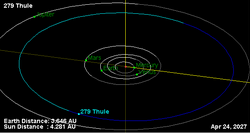Astronomy:279 Thule
 Orbital diagram | |
| Discovery | |
|---|---|
| Discovered by | Johann Palisa |
| Discovery date | 25 October 1888 |
| Designations | |
| (279) Thule | |
| Pronunciation | /ˈθjuːliː/[2] |
| A888 UA, 1920 GA 1923 RA, 1927 EC 1954 FF[1] | |
| Minor planet category | Asteroid belt (Thule) |
| Adjectives | Thulean /ˈθjuːliən/[3] |
| Orbital characteristics[1] | |
| Epoch 31 July 2016 (JD 2457600.5) | |
| Uncertainty parameter 0 | |
| Observation arc | 125.34 yr (45780 d) |
| |{{{apsis}}}|helion}} | 4.4617880 astronomical unit|AU (667.47398 Gm) |
| |{{{apsis}}}|helion}} | 4.2367660 AU (633.81117 Gm) |
| 4.3492770 AU (650.64258 Gm) | |
| Eccentricity | 0.025869 |
| Orbital period | 9.07 yr (3313.0 d) |
| Mean anomaly | 62.75874° |
| Mean motion | 0° 6m 31.184s / day |
| Inclination | 2.323774° |
| Longitude of ascending node | 72.46791° |
| 42.36797° | |
| Physical characteristics | |
| Dimensions | 126.59±3.7 km (IRAS)[1] |
| Rotation period | 23.896 h (0.9957 d)[1] |
| Geometric albedo | 0.0412±0.003[1] |
| Physics | 133 K |
| B−V=0.75[1] U−B=0.32[1] D (Tholen)[1] X (SMASSII)[1] | |
| Absolute magnitude (H) | 8.57[1] |
Thule, minor planet designation: 279 Thule, is a large asteroid from the outer asteroid belt. It is classified as a D-type asteroid and is probably composed of organic-rich silicates, carbon and anhydrous silicates. Thule was the first asteroid discovered with a semi-major axis greater than 4 AU. It was discovered by Johann Palisa on 25 October 1888 in Vienna and was named after the ultimate northern land of Thule.
Thule asteroids
Thule was the first discovered member of the Thule dynamical group, which as of 2008 is known to consist of three objects: 279 Thule, (186024) 2001 QG207, and (185290) 2006 UB219.[4] The orbits of these bodies are unusual. They orbit in the outermost edge of the asteroid belt in a 4:3 orbital resonance with Jupiter, the result of the periodic force Jupiter exerts on a body with Thule's orbital period, in the same way (though with the reverse effect) as the Kirkwood gaps in the more inner parts of the asteroid belt.
| Name | semimajor axis (au) | period (years) | eccentricity | inclination (°) | absolute magnitude | Size (km) |
|---|---|---|---|---|---|---|
| 279 Thule | 4.269 | 8.82 | 0.0432 | 2.334 | 8.53 | 126.59±3.7 |
| (185290) 2006 UB219 | 4.290 | 8.89 | 0.1335 | 7.132 | 13.84 | 5.85 4.1–10.1
|
| (186024) 2001 QG207 | 4.278 | 8.85 | 0.2513 | 3.238 | 14.53 | 4.26 3.0–7.4
|
| 2006 SJ42 | 4.286 | 8.87 | 0.0465 | 5.501 | 15.1 | 3.28 2.3–5.7
|
| 2008 RE93 | 4.288 | 8.88 | 0.1161 | 3.497 | 15.49 | 2.74 1.9–4.7
|
| 2014 WN504 | 4.297 | 8.91 | 0.2312 | 3.193 | 15.5 | 2.73 1.9–4.7
|
| 2014 QX231 | 4.283 | 8.86 | 0.3722 | 5.935 | 16.5 | 1.72 1.2–3.0
|
References
- ↑ 1.0 1.1 1.2 1.3 1.4 1.5 1.6 1.7 1.8 1.9 "279 Thule". JPL Small-Body Database. NASA/Jet Propulsion Laboratory. https://ssd.jpl.nasa.gov/sbdb.cgi?sstr=279;cad=1.
- ↑ Thule (3rd ed.), Oxford University Press, September 2005, http://oed.com/search?searchType=dictionary&q=Thule (Subscription or UK public library membership required.)
- ↑ Thulean (3rd ed.), Oxford University Press, September 2005, http://oed.com/search?searchType=dictionary&q=Thulean (Subscription or UK public library membership required.)
- ↑ Brož, M.; Vokrouhlický, D. (2008). "Asteroid families in the first-order resonances with Jupiter". Monthly Notices of the Royal Astronomical Society 390 (2): 715–732. doi:10.1111/j.1365-2966.2008.13764.x. Bibcode: 2008MNRAS.390..715B.
External links
- 279 Thule at AstDyS-2, Asteroids—Dynamic Site
- 279 Thule at the JPL Small-Body Database
 |

